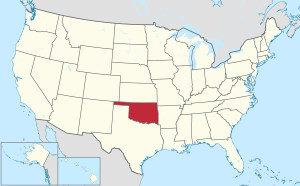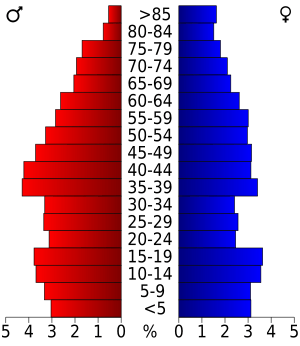Okfuskee County, Oklahoma facts for kids
Quick facts for kids
Okfuskee County
|
|
|---|---|

Okfuskee County Courthouse
|
|

Location within the U.S. state of Oklahoma
|
|
 Oklahoma's location within the U.S. |
|
| Country | |
| State | |
| Founded | 1907 |
| Seat | Okemah |
| Largest city | Okemah |
| Area | |
| • Total | 629 sq mi (1,630 km2) |
| • Land | 619 sq mi (1,600 km2) |
| • Water | 10 sq mi (30 km2) 1.6%% |
| Population
(2020)
|
|
| • Total | 11,310 |
| • Density | 17.981/sq mi (6.942/km2) |
| Congressional district | 2nd |
Okfuskee County is a county located in the state of Oklahoma in the United States. As of the 2020 census, about 11,310 people lived there. Its main town, or county seat, is Okemah. The county got its name from an old Muscogee town. This town was in what is now Cleburne County, Alabama. It was named after the Okfuskee, a Muscogee tribe.
Contents
History of Okfuskee County

The land that is now Okfuskee County was once home to the Quapaw and Osage tribes. They lived here until 1825. In that year, they gave the land to the United States government.
The Creek people moved to this area in the early 1830s. They built two towns called Greenleaf and Thlopthlocco. During the American Civil War, Thlopthlocco was used as a base for Confederate Colonel Douglas H. Cooper. Greenleaf was where Chief Opothleyahola stayed. He tried to keep the Creek people united. Later, he led over 5,000 Creeks to Kansas to avoid the war.
After the Civil War, the Creek people had to free their African American slaves. Many of these freed people stayed in the area. They started their own towns, which were all-black communities. Some of these towns included Boley, Bookertee, Clearview, Chilesville, and Rusk. Another Creek town, Okfuskee, grew up around Samuel Checote's trading post after the war.
Railroads also came to the area. The St. Louis and San Francisco Railway built a line from north to south between 1901 and 1903. The Fort Smith and Western Railroad built a line from east to west in 1903.
Okfuskee County was officially created in 1907 when Oklahoma became a state. Okemah was chosen as the county seat. Oil and gas production started in the county in 1914. The Prairie Oil and Gas Company found oil near Paden. More oil wells were found in other parts of the county. This led to a big increase in population, which was highest in 1930.
Geography and Nature
According to the U.S. Census Bureau, Okfuskee County covers a total area of about 629 square miles. About 619 square miles of this is land, and 10 square miles (1.6%) is water. The county is located in a region known as the Sandstone Hills.
The northeastern part of the county is drained by the Deep Fork of the Canadian River. The southern part is drained by the North Canadian River.
Main Roads
Neighboring Counties
- Creek County (north)
- Okmulgee County (east)
- McIntosh County (southeast)
- Hughes County (south)
- Seminkee County (southwest)
- Pottawatomie County (southwest)
- Lincoln County (west)
People of Okfuskee County
| Historical population | |||
|---|---|---|---|
| Census | Pop. | %± | |
| 1910 | 19,995 | — | |
| 1920 | 25,051 | 25.3% | |
| 1930 | 29,016 | 15.8% | |
| 1940 | 26,279 | −9.4% | |
| 1950 | 16,948 | −35.5% | |
| 1960 | 11,706 | −30.9% | |
| 1970 | 10,683 | −8.7% | |
| 1980 | 11,125 | 4.1% | |
| 1990 | 11,551 | 3.8% | |
| 2000 | 11,814 | 2.3% | |
| 2010 | 12,191 | 3.2% | |
| 2020 | 11,310 | −7.2% | |
| U.S. Decennial Census 1790-1960 1900-1990 1990-2000 2010 |
|||
In 2010, there were 12,191 people living in Okfuskee County. Most people, about 64.4%, were White. About 19.7% were Native American, and 8.3% were Black or African American. A small number were Asian (0.2%) or Pacific Islander (0.1%). About 0.8% were of another race, and 6.5% were of two or more races. About 2.9% of the people were Hispanic or Latino (of any race).
In 2000, there were 11,814 people. The county had about 7 people per square kilometer. Most people spoke English (92.5%). Some also spoke Muskogee (3.5%), Spanish (2.1%), or German (1.3%).
There were 4,270 households in 2000. About 29.2% of these households had children under 18 living with them. About 54.1% were married couples living together. The average household had about 2.52 people.
The population was spread out by age. About 24.6% were under 18 years old. About 16.3% were 65 years or older. The average age was 39 years.
Communities in Okfuskee County
City
- Okemah (This is the main town, or county seat)
Towns
Census-designated place
Unincorporated communities
Historic Places (NRHP sites)
Several places in Okfuskee County are listed on the National Register of Historic Places. This means they are important historical sites.
- Boley Historic District, Boley
- Okemah Armory, Okemah
- Okfuskee County Courthouse, Okemah
- Weleetka Town Hall and Jail, Weleetka
See also
 In Spanish: Condado de Okfuskee para niños
In Spanish: Condado de Okfuskee para niños


